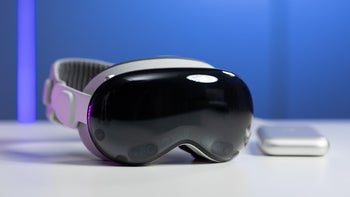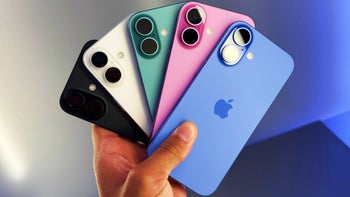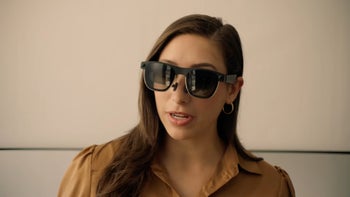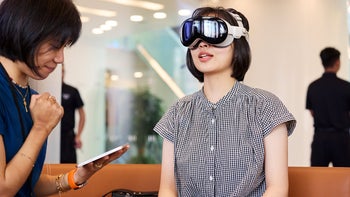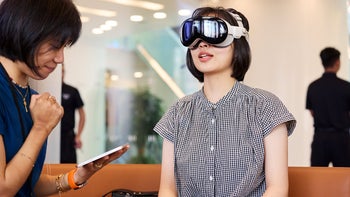Apple visionOS release date, games, and news

VisionOS is what Apple chose to call the proprietary operating system (OS) that the Vision Pro headset runs. And, as you probably know: the Vision Pro is the Big A's very own, first-of-its-kind "spatial computer".
Well, here's the thing: spatial computation, especially in the case of the Vision Pro, practically relies on software in order to properly execute all of its AR (augmented reality) and MR (mixed-reality) shenanigans. Hence: VisionOS is pretty integral to the experience.
VisionOS initially released on February 2, 2024, which coincides with the release date for the Vision Pro itself, naturally. Initially, the headset (and it's OS) were only available in the US, but that is set to change soon. Apple announced that the Vision Pro is (finally) set for a wider release at WWDC 2024.
But more importantly: the Cupertino Company announced the first ever major OS upgrade to VisionOS itself during the livestream too. Aptly titled VisionOS 2, the update focuses on quality of life updates and a couple of expanded, fresh features.
As of September 16, 2024, visionOS 2, the latest available version, coming to bring mouse support, new gestures, home screen customization and virtual desktop enhancements, among other small but key features.
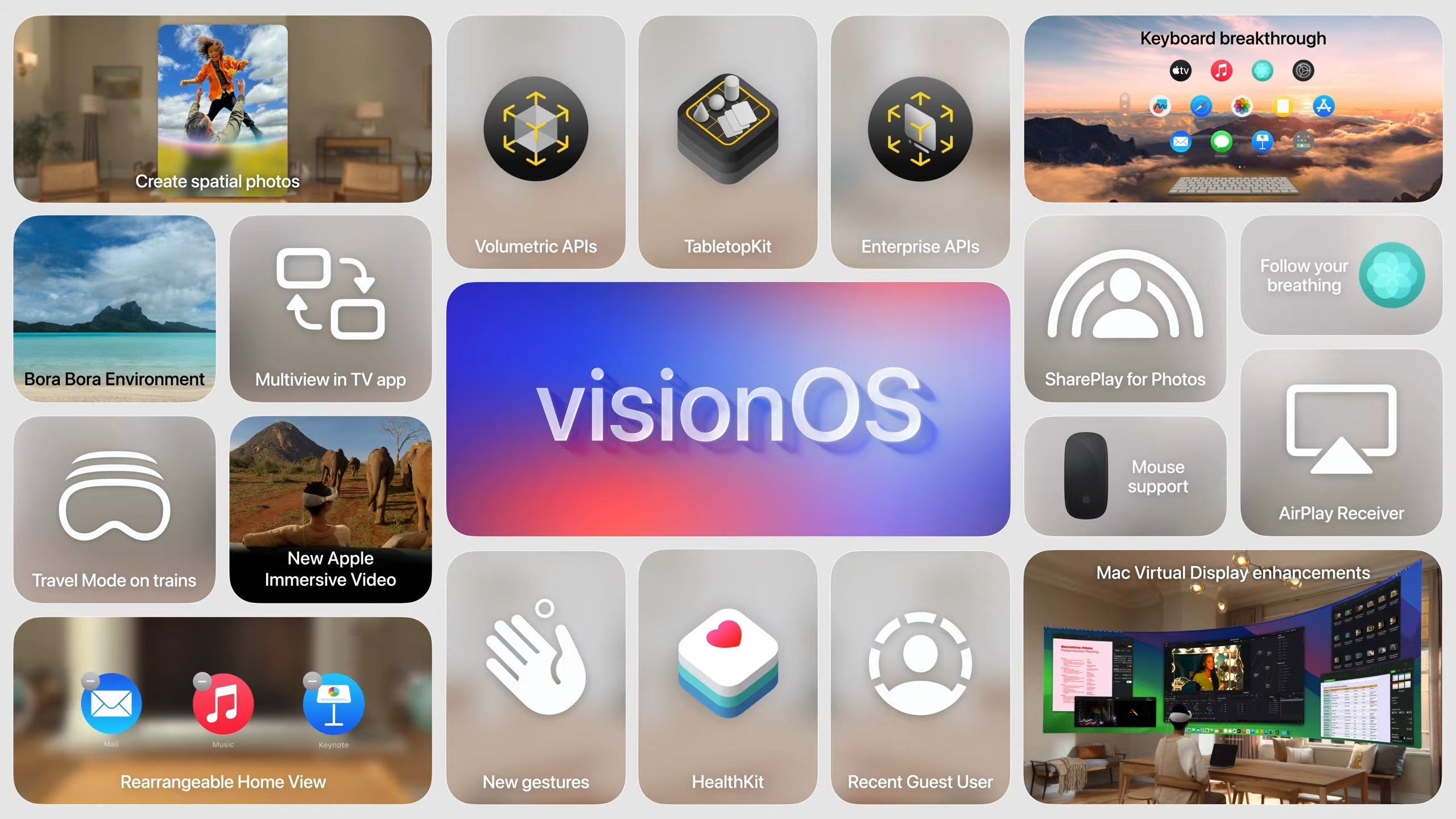
The TL;DR version of VisionOS 2. Image credit — Apple
Jump to:
Latest News
Name

The initial name for the OS was not VisionOS, but xrOS, and the leaks we've seen supported that theory. Apple has most recently trademarked the name xrOS, which is our pretty solid indication that this could indeed be the final name of its AR/VR operating system, as opposed to the previously-speculated realityOS.
Then again, Apple did trademark realityOS also, back in 2022, so that name remains a possibility too.
It's quite apparent that xrOS stands for "extended reality operating system", which is a perfectly apt and simple name, albeit realityOS would have arguably been the more friendly and universally-understandable one to go with.
Apple announced the first ever major OS upgrade to VisionOS on June 10, 2024 during it's annual WWDC event. The showcase was first-in-line for the livestream and promised a release date for Fall of 2024.
Release Date
But if for some reason you can't believe what Apple's own CEO is saying, there's another related fact that confirms the 2024 expectations: Apple plans to train it's employees on the Vision Pro at the start of 2024. And that includes the people working in stores too, so if they need to become acquainted with the headset at the start of the year, the release date will probably not be far behind.
Apple visionOS was unveiled on June 5th, 2023, during Apple's WWDC 2023 event. Its release date would naturally match the release date of Apple's first AR/VR headset, which would also be the first device to run the new operating system.
Effectively, visionOS "released" on February 2, 2024 when the official launch of the Vision Pro took place. As of now, the launch is limited to the US alone. It is expected of Apple to bring the Vision Pro to China and parts of the EU by the end of 2024.
Vision OS 2, and eventually Vision OS 2.1, and several 2.2 betas came out in September 16, 2024.
Apps

VisionOS has it's own App Store, but the apps offered there are not limited to visionOS alone. Since visionOS is effectively a fork of iPadOS — itself a fork of iOS — it can run most iPad apps too.
That being said, there are notable exceptions. For one reason or another, notable apps like YouTube or Netflix are not available for the Vision Pro, neither in the form of dedicated apps or iPad apps. That being said, you can still enjoy the content from similar platforms through Safari.
While this situation means that visionOS has tons upon tons of apps available to it, it also means that few of them are actually built with visionOS and spatial computation in mind. Whenever such an app becomes available, however, it is almost always notable and impressive.
That, in turn, promises a bright future for visionOS, when the Vision Pro sees higher adoption levels after a worldwide launch.
VisionOS and 3D movies
It took until a teardown of the Apple TV app in order for it to become official: 3D movies are there! These titles have a special Vision Pro-inspired icon to let users know that the feature is supported.
Here is a list of the first batch of 3D movies available for the Vision Pro:
- 47 Ronin
- Cirque Du Soleil: Worlds Away Everest
- Hansel and Gretel Witch Hunters
- Jurassic World: Dominion
- Kung Fu Panda 3
- Mortal Engines
- Pacific Rim Uprising
- Sanctum
- Shrek
- Skyscraper
- Tad Stones and the Secret of King Midas
- The Boss Baby: Family Business
- The Little Princess
- The Nut Job 2: Nutty by Nature
- The Secret Life of Pets 2
- Trolls
- Trolls World Tour
- Warcraft
The visionOS version of the TV app seems has a special "Play in 3D" button, exclusive for the Vision Pro UI too.
The Vision Pro lets you utilize the real space around you for AR
One of the Vision Pro's biggest draws — and by extension, of visionOS' as well — is spatial computation. This technology allows you to utilize the space around you via high-quality passthrough mode and overlay digital items on top of your real life surroundings.
This means that the Vision Pro can be a portable workstation, allowing you to set up multiple virtual monitors. VisionOS also supports a really nifty feature, allowing you to just look at a MacBook and duplicate it's display in mixed reality, allowing for a bigger size and higher resolution.
That being said, a huge limitation of this feature is that the Vision Pro does not let you use it as for a dual-monitor setup, at least for the time being.
That being said, Apple has confirmed that the idea of full-body tracking isn't something that it's interested in with the Vision Pro. And, for the most part, that makes sense, as the marketing primarily features situations and use-cases where you wouldn't need to move about a lot. Plus, even VR games don't always require you to actively move yourself around.
And that, in turn, enables Apple's XR headset to allow its user to create a setup, unique to them, because you can place virtual windows and monitors everywhere. The Vision Pro, however, won't be able to remember your setups forever and for the time being: you can't save different setups as presets, dedicated to separate locations.
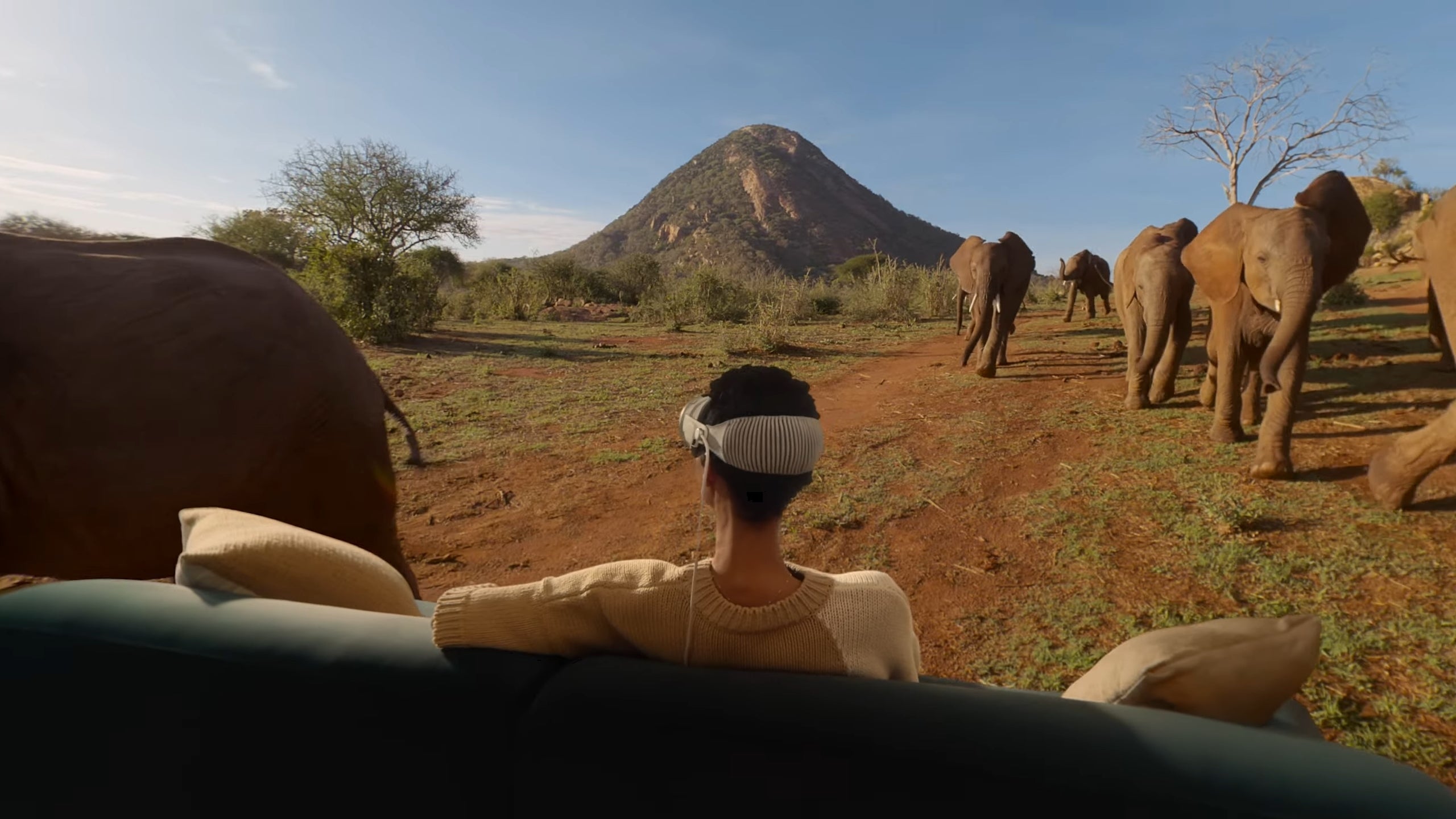
Part of Apple's expanded Spatial Video presentation during WWDC of 2024. | Image credit — Apple
During WWDC of 2024, Apple promised a lot more spatial-oriented content coming to Vision Pro. Interestingly, that included a first-of-its-kind short film, shot entirely in Apple's Spatial Video format. We're still waiting on details for all of these projects as of June, 2024.
Apple visionOS games
You can play all Apple Arcade and most iPad games on the Vision Pro virtual reality headset, in flatscreen virtual windows. For some, touch controls (on the virtual screen) work, but for others you will need a dedicated controller, but no worries: the Vision Pro supports a lot of those, including ones from PlayStation or Xbox.
What about VR games though? Well, there are some, but they are few. The quality is great, but heavy-hitters like Beat Sabers or Demeo are not yet available on the platform. That is primarily due to the Vision Pro not coming with dedicated controllers.
That, in turn, also means that PC VR gaming is pretty much out of the question natively. That being said, numerous devs have started working on special apps and features to enable you to enjoy PC VR gaming on the Vision Pro. Apple doesn't seem to mind, so in a year or so, we may actually have a pretty solid, albeit third-party, solution to this conundrum.
Unity launched a beta of its popular engine for visionOS, so we can basically rest assured that games will be a thing on the Vision Pro. The bar to entry remains at $0, so if you ever wanted to try game design for VR, this is a perfect opportunity.
During WWDC of 2024, Apple didn't talk much about gaming on VisionOS, though a certain upcoming endless runner was showcased. All other devices from the Apple family had segments dedicated to gaming, which made the Vision Pro feel lacking in that department during the livestream.
Features, interface
VisionOS follows Apple's general design philosophy, so if you're knees deep in the Big A's ecosystem, you'll feel right at home with the Vision Pro. The most notable difference will likely be the way you navigate around, namely: through hand tracking, which we found feels like magic.
VisionOS presents a series of workflows that feel second nature to an extent, where it's difficult to get used to not using them again. There are also a lot of hidden easter eggs around visionOS, making it not only enjoyable, but also fun to explore the UI itself.
The Vision Pro is equipped with a Digital Crown, similar to that of the Apple Watch. It has a multitude of features, including allowing users to tune in and out of VR or their preferred level of immersion.
Some of the most notable Vision Pro features are:
- Personas: a virtual avatar that the Vision Pro creates for you during setup. The feature is still in beta, but has improved significantly since launch.
- EyeSight: a feature which allows your eyes to be displayed on the Vision Pro's frontal display, so that others around you can feel more connected to you while you're wearing Apple's headset. This is one of the most controversial features of visionOS. While it is praised for it's innovative concept, it's execution and functionality has often been described as lacking.
- Spatial videos: a new format of video file, which users can capture through the Vision Pro or an iPhone 15 Pro. It is intended to be viewed on the Vision Pro, but competing brands such as Meta have added support for it to headsets like the Quest 3 too. The format initially seems like a 3D video, but it is more immersive and in a different way.
- Spatial computation: arguably, the Vision Pro's biggest draw, this allows powerhouse users and productivity freaks to carry a virtual setup practically anywhere. This feature is expected to grown in feature set and application as time goes on.
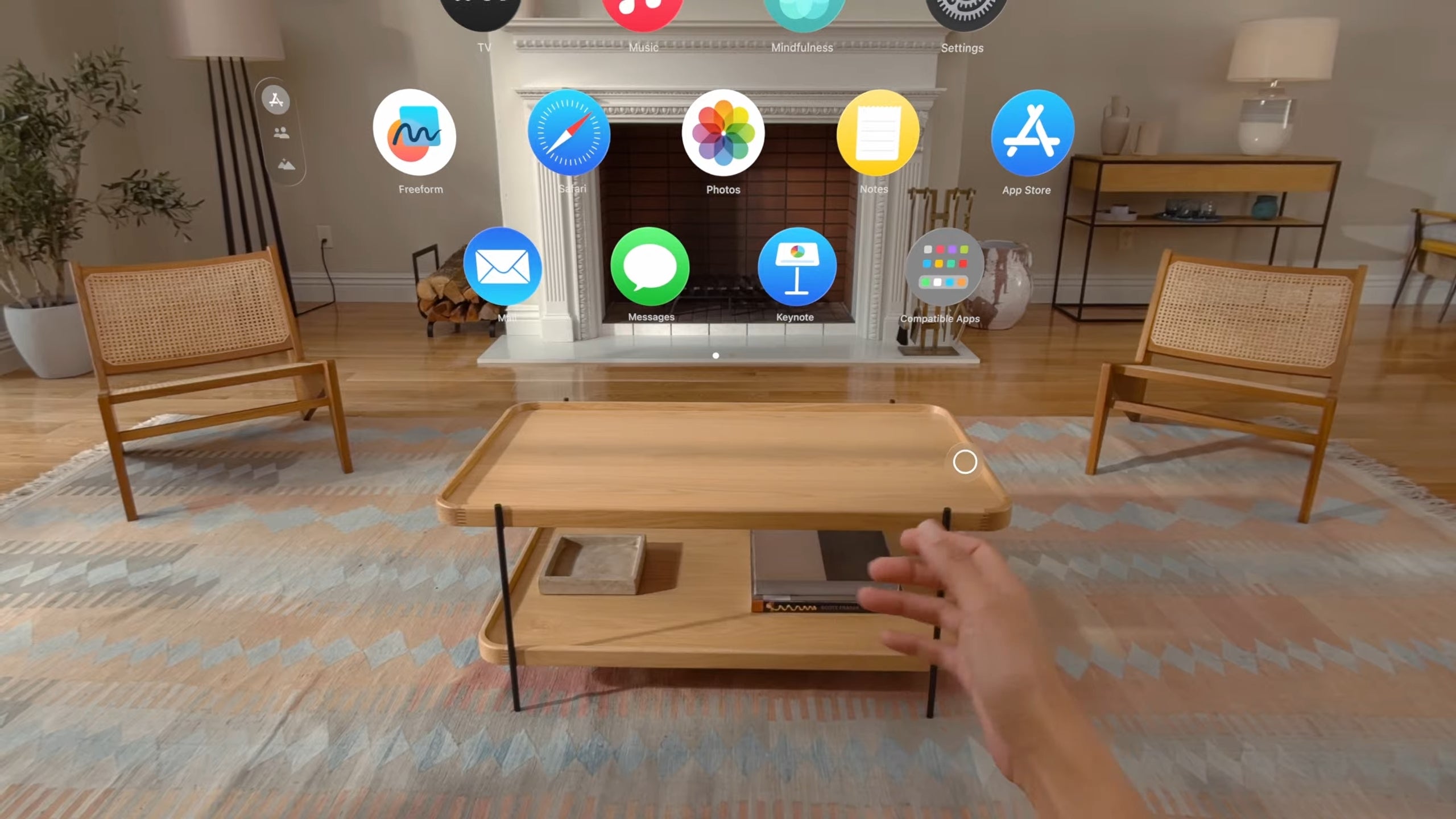
With VisionOS 2, the menu can be brought up with a simple flick of the wrist. | Image credit — Apple
During WWDC of 2024, Apple showcased some of the new features coming to the Vision Pro with VisionOS. The updates can be separated in two primary categories:
- Related to spatial video, like new formats to record video in or new spatial content coming soon to Vision Pro
- Quality of life features, such as new ways of bringing up menus and toggles
For multitaskers, the biggest promise is related to a new virtual screen mode, which will let wearers duplicate their Mac's screen to an ultrawide virtual monitor, equivalent to two 4K displays.

Now that's a big virtual screen! | Image credit — Apple
Spatial Video seems to be featured prominently and it seems like Apple is heavily focused on it. That being said, almost nothing practical was shown during WWDC 2024, so we'll have to wait until Fall of 2024 to learn more about VisionOS 2's hidden tricks (spatial or otherwise).
